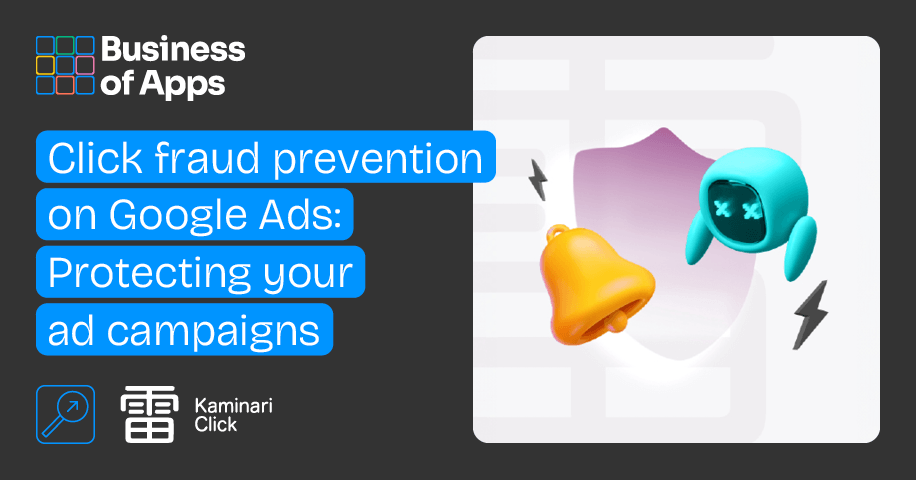In the dynamic world of online advertising, Google Ads has become a vital tool for anyone engaged in digital marketing. However, one significant issue advertisers face today is click fraud. This article will explore the intricacies of click fraud and its impact on advertising campaigns and provide practical solutions to protect your advertising budget and enhance campaign effectiveness.
Understanding click fraud
What is click fraud?
Click fraud is a malicious activity where individuals, automated scripts, or bots generate fake clicks on pay-per-click (PPC) ads. The primary goal is to deplete advertising budgets without delivering real traffic or conversions. Click fraud can manifest in various forms, including automated schemes, click farms, competitor diversions, and even accidental clicks by users.
Types of click fraud
Click fraud is a serious issue for advertisers using Google Ads, and there are numerous methods that perpetrators use to deplete your advertising budgets. Let’s delve deeper into the main types of fraudulent clicks.
Automated schemes
Automated schemes involve the use of bots programmed to repeatedly click on ads. These bots can mimic human behavior, including random mouse movements and pauses between clicks, making them difficult to detect. They can also scale attacks, generating thousands of fake clicks in a short period, rapidly depleting advertising budgets. Due to their ability to mimic human behavior, such bots can skew analytics data, making it challenging to accurately assess campaign effectiveness and make informed decisions.
Click farms
Click farms are groups of people hired to manually click on ads. These operations often occur in low-wage countries and can involve massive setups known as “click farms.” Hundreds or even thousands of individuals can work in such farms, quickly generating a significant number of fake clicks. The complexity of detecting these clicks arises because they are made by real people, making them harder to identify compared to automated bots. Click farms can be located anywhere in the world, complicating their tracking and blocking.
Competitors
Competitors may engage in click fraud to deplete your advertising budget, reducing not only your ad visibility but also your company’s site presence in search engines. To prevent this, do not reduce your advertising budget—as doing so only increases the chances of your competitors achieving higher ad positions.
Detecting such clicks is challenging because they occur from real devices and IP addresses. However, detecting such activities is not impossible. Specialized anti-fraud systems exist that monitor all suspicious activity in your ads and filter out fraudulent clicks before they are processed.
Accidental clicks
Not all fraudulent clicks are intentional. Some clicks can result from accidental actions by users, including:
- User errors: Users might accidentally click on an ad while trying to close a pop-up window or perform another operation on the site.
- Mobile devices: The likelihood of accidental clicks is higher on mobile devices due to the smaller screen size and potential for touch errors.
- Improper ad placement: Clicks can occur due to poor ad placement on a site, where users accidentally click on ads instead of the intended content.
Understanding the different types of click fraud allows advertisers to more effectively develop strategies to protect and minimize losses. By using both automated tools and manual methods of monitoring and analysis, you can significantly reduce the risk of data distortion and excessive spending on fake clicks.
Impact on analytics and budget
Click fraud significantly distorts key performance indicators, such as click-through rate (CTR), conversion rates, and the overall effectiveness of campaigns. Advertisers may see inflated CTRs without corresponding increases in conversions, leading to incorrect strategies and budget losses.
How does click fraud impact advertisers on Google Ads?
Click fraud is a serious threat to advertisers using the Google Ads platform. It negatively affects various aspects of their marketing campaigns and business as a whole. Let’s explore in detail how fraudulent clicks can damage advertisers.
Financial losses
Click fraud leads directly to the loss of advertising funds. When budgets are spent on fraudulent clicks, advertisers lose money without receiving the desired return on investment (ROI). For small businesses and startups, these financial losses can be particularly devastating. Specifically:
- Budget constraints: If you are a small company or startup operating with limited budgets, even minor losses can significantly impact your ability to compete in the market.
- Reduced growth opportunities: Financial losses due to fraud can limit opportunities for expanding advertising campaigns and implementing new marketing strategies.
Reduced ROI
Fake clicks increase advertising costs without generating real engagement or sales. This leads to a reduction in ROI, making advertising campaigns less profitable and sometimes unviable. Consequences of reduced ROI include:
- Inefficient resource use: Invested funds and efforts do not yield the expected return, making advertising investments less profitable.
- Difficulties in justifying expenses: It may be challenging for management to justify current advertising expenditures if ROI is significantly reduced due to fraud.
Distortion of performance metrics
Click fraud distorts critical performance metrics, making it difficult for advertisers to assess the real effectiveness of their campaigns. False data can lead to incorrect decisions and adjustments in strategies, which may not address the underlying issues. The impact of metric distortion includes:
- Erroneous conclusions: Analyzing data based on fraudulent clicks may lead to incorrect conclusions about which aspects of the campaign are working well and which are not.
- Ineffective adjustments: Making changes to a campaign based on distorted data can exacerbate problems and lead to further reductions in advertising effectiveness.
Loss of trust and reputation
Repeated incidents of click fraud can undermine trust in the advertising platform and the effectiveness of digital marketing strategies. Advertisers may become skeptical about the value of online advertising, which can affect their willingness to invest in future campaigns. Specific consequences include:
- Reduced confidence in digital marketing: Negative experiences with fraudulent clicks may lead companies to be less willing to use online advertising as part of their marketing strategy.
- Worsened relations with the platform: Loss of trust in Google Ads and other advertising platforms can lead to reduced collaboration and decreased investments in their use.
- Brand reputation risk: Ongoing problems with the effectiveness of advertising campaigns can affect the company’s perception by customers and partners.
Click fraud has a comprehensive negative impact on advertisers, undermining their financial status, the effectiveness of marketing campaigns, and trust in advertising platforms. Effective management and prevention of click fraud are key factors in maintaining successful and profitable advertising strategies.
How does Google fight click fraud?
Automated systems and manual reviews
Google uses a combination of automated systems and manual reviews to detect and prevent click fraud. These systems employ sophisticated algorithms and machine learning models to identify suspicious activity in real time.
Monitoring various data points
Google tracks a multitude of data to detect anomalies, including user behavioral patterns, IP addresses, and historical click data. This comprehensive approach helps effectively detect and mitigate fraudulent activity.
Reporting suspicious activity
Advertisers have the option to report suspicious activity directly to Google. This feedback helps Google improve its detection systems and provides some protection for advertisers suspecting fraudulent activity.
How to recognize click fraud on Google Ads
Metrics to monitor
While it might sound simplistic, advertisers should closely monitor key metrics such as CTR, conversion rates, and bounce rates. Unusually high CTRs with low conversion rates may indicate click fraud.
Analyzing IP addresses and interaction patterns
Analyzing the IP addresses of users clicking on ads and their interaction patterns can help identify discrepancies. Multiple clicks from a single IP address or unusual geographic patterns may signal fraudulent activity.
Comparing Google Ads and Google Analytics data
Discrepancies between Google Ads and Google Analytics data may suggest possible click fraud. For example, if Google Ads reports high traffic but Google Analytics shows low engagement or conversions, this could indicate fraudulent clicks.
Tips for identifying suspicious activity
Detecting click fraud is a key aspect of protecting advertising campaigns and budgets. Here are some primary methods for detecting suspicious activity:
Monitoring sudden spikes
One of the first signs of possible click fraud is a sudden increase in the number of clicks without a corresponding growth in conversions. Such anomalies can lead to serious issues and loss of advertising budget, so pay attention to sharp changes in click numbers over short periods. If these spikes do not align with your usual marketing efforts or seasonal trends, they may indicate fraud.
Also, compare current data with similar periods in the past. Significant deviations may be an indicator of suspicious activity.
Analyzing geographic data
Analyzing the geographic origin of clicks can help uncover fraud. A sudden influx of traffic from unusual locations can be a sign of fraudulent activity. If your ads suddenly receive many clicks from regions where your target audience does not reside, this could be a sign of fraud. Match click data with regions where your advertising is usually effective. Click spikes from areas atypical for your business should raise suspicion.
Using third-party tools
Using specialized tools for detecting click fraud can significantly ease the process of identifying suspicious activity. These systems automate the detection of fraudulent clicks, using complex algorithms and big data analysis to identify anomalies.
They provide detailed reports that include all suspicious activities, including information on timing, sources, and behaviour patterns. This helps you better understand the nature of the fraud.
Many of these tools integrate easily with Google Ads and other platforms, allowing you to more effectively manage campaigns and quickly respond to threats.
These tips will help you promptly detect suspicious activity and protect your advertising budgets from fraudulent actions.
Preventing click fraud: Strategies and tools
Manual methods for prevention
Manual methods of preventing click fraud can be just as effective as automated solutions. They allow advertisers to more precisely control their campaigns and take action based on specific observations and analysis. Here are some key methods that can help you protect your advertising budget.
Excluding IP addresses
Regularly updating exclusion lists of IP addresses is an important step in preventing fraudulent clicks. You can manually add known IP addresses associated with fraudulent clicks to exclusion lists. This allows you to block traffic from these addresses, preventing further budget losses.
Periodically analyze your campaigns to identify new suspicious IP addresses and add them to exclusion lists. This helps maintain the relevance and effectiveness of your protection.
You can also use databases of suspicious and fraudulent IP addresses. These databases are regularly updated and can help you effectively block unwanted traffic.
Scheduling ad displays
Properly scheduling ad displays can significantly reduce the risk of fraudulent clicks. Determine the hours when your target audience is most active online. For example, if you know your customers are often online in the evening, set your ad displays for this time.
Avoid displaying ads during off-hours or periods when the likelihood of receiving fraudulent clicks is higher. For example, late-night displays may attract more bots and fraudsters.
Continuously test different time intervals for ad displays and optimize them based on the data obtained. This will help you make the most of your advertising budget and minimize losses.
Geographic targeting
Geographic targeting allows you to limit ad displays to regions with a real interest in your product or service. Set up ad displays only in regions where your target audience is genuinely interested in your offering. When setting up GEO, consider regions with a high rate of fraudulent activity, often Tier-3 countries. Exclude or limit ad displays in these regions to reduce the likelihood of fraud.
Adapt your advertising messages to the cultural and linguistic characteristics of target regions. This will help attract more relevant traffic and improve campaign metrics.
Using manual methods to prevent click fraud allows advertisers to more flexibly and accurately control their campaigns. Combining these methods with automated tools can create a robust defense against fraudulent clicks and ensure maximum effectiveness of your advertising efforts.
Automated tools
Automated tools are critical for effectively preventing click fraud. They allow advertisers to quickly and effectively detect and block suspicious activity, minimizing the impact of fraudulent clicks on their campaigns. Let’s explore some key approaches and tools.
Services for detecting click fraud
Using an anti-fraud service can significantly enhance the protection of your advertising campaigns against fraudulent clicks. The anti-fraud system automatically tracks activity on your ads and identifies suspicious clicks, blocking IP addresses involved in fraud. Many of these systems integrate directly with Google Ads and other advertising platforms, simplifying campaign management and monitoring.
The anti-fraud also provides detailed reports on detected fraudulent clicks, including information on traffic sources, which helps you better understand and analyze threats.
Real-time monitoring
Implementing tools for real-time monitoring and alerts about suspicious activity is an integral part of a strategy to protect against click fraud. Constant monitoring allows for the timely detection of traffic anomalies, such as sudden spikes in click numbers or unusual geographic sources. The system alerts you to suspicious activity in real time, enabling you to quickly respond and take measures to protect your budget.
Monitoring tools can be customized to your specific needs, providing scalable protection for both small and large advertising campaigns.
Advanced machine learning algorithms
Using machine learning algorithms to continuously improve the capabilities for detecting click fraud represents an advanced approach in combating this type of fraud. Machine learning allows for the analysis of vast amounts of data and the identification of patterns that may indicate fraud. This helps create more accurate models for detecting suspicious activity.
The algorithms are constantly trained on new data, allowing them to adapt to changing methods of fraud and improve detection accuracy. Advanced algorithms can predict potential threats based on historical data and current trends, enabling preventive measures to protect advertising campaigns.
Implementing these automated tools helps advertisers not only protect their budgets but also significantly enhance the overall effectiveness and accuracy of their advertising campaigns. By using modern technologies and approaches, you can confidently counteract click fraud and maintain a competitive edge in the world of online advertising.
Conclusion
Click fraud poses a significant threat to the effectiveness and financial health of campaigns on Google Ads. By understanding the nature of click fraud, its impact, and measures for its detection and prevention, advertisers can protect their advertising budgets and ensure more accurate performance metrics. Implementing both manual and automated strategies is important for maintaining the integrity of online advertising efforts.
To protect your campaigns, consider using advanced anti-fraud tools and stay vigilant, monitoring key metrics and reporting suspicious activity. Protection from click fraud not only preserves your advertising budget but also strengthens trust in your digital marketing strategies.
By taking proactive measures against click fraud, you can maximize the return on investment in advertising and enhance the overall effectiveness of your campaigns on Google Ads.











